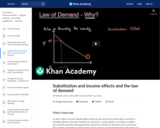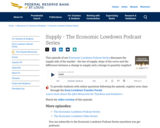34 Results

- Subject:
- Economics
- Social Science
- Material Type:
- Unit of Study
- Provider:
- Rice University
- Provider Set:
- OpenStax College

In this chapter, you will learn about:
Macroeconomic Perspectives on Demand and Supply
Building a Model of Aggregate Demand and Aggregate Supply
Shifts in Aggregate Supply
Shifts in Aggregate Demand
How the AD/AS Model Incorporates Growth, Unemployment, and Inflation
Keynes’ Law and Say’s Law in the AD/AS Model
- Subject:
- Mathematics
- Material Type:
- Module
- Date Added:
- 09/20/2018

By the end of this section, you will be able to:
Explain Say’s Law and understand why it primarily applies in the long run
Explain Keynes’ Law and understand why it primarily applies in the short run
- Subject:
- Mathematics
- Material Type:
- Module
- Date Added:
- 09/20/2018

14.01 Principles of Microeconomics is an introductory undergraduate course that teaches the fundamentals of microeconomics. This course introduces microeconomic concepts and analysis, supply and demand analysis, theories of the firm and individual behavior, competition and monopoly, and welfare economics. Students will also be introduced to the use of microeconomic applications to address problems in current economic policy throughout the semester.
This course is a core subject in MIT's undergraduate Energy Studies Minor. This Institute-wide program complements the deep expertise obtained in any major with a broad understanding of the interlinked realms of science, technology, and social sciences as they relate to energy and associated environmental challenges.
Course Format
This course has been designed for independent study. It includes all of the materials you will need to understand the concepts covered in this subject. The materials in this course include:
A complete set of Lecture Videos by Prof. Jon Gruber.
Reading Assignments in your choice of two textbooks – one of which is a free online edition - as preparation for the lectures.
Multiple-choice Quizzes to assess your understanding of the key concepts in each session.
Problem Sets with solution keys to test your ability to apply to concepts covered in lecture, and Problem Solving Videos to provide step-by-step instruction through several problem set solutions.
A collection of links For Further Study to provide supplemental online content.
A full set of Exams, including review material and practice exams to help you prepare.
- Subject:
- Economics
- Social Science
- Material Type:
- Full Course
- Provider:
- MIT
- Provider Set:
- MIT OpenCourseWare
- Author:
- Gruber, Jonathan
- Date Added:
- 09/01/2011

In this active learning lesson, students apply economic concepts to a professional baseball league. The lesson underscores the importance of incentives, control of supply, and potential market inefficiencies resulting from a cartel. Students assume one of two roles: either (i) a member of a team owner group trying to get its team into the Professional Baseball League or (ii) a member of the Professional Baseball League Expansion Committee deciding whether new teams are admitted.
- Subject:
- Economics
- Social Science
- Material Type:
- Lesson
- Lesson Plan
- Provider:
- Federal Reserve Bank of St. Louis
- Provider Set:
- Economic Lowdown Lessons
- Author:
- Kris Bertelsen
- Date Added:
- 09/11/2019

The law of demand states that quantity demanded increases when price decreases, but why? Two reasons why the demand curve slopes downward are the substitution effect and the income effect. The income effect states that when the price of a good decreases, it is as if the buyer of the good's income went up. The substitution effect states that when the price of a good decreases, consumers will substitute away from goods that are relatively more expensive to the cheaper good. Learn about the role of the income effect and the substitution effect on the shape of the demand curve in this video.
- Subject:
- Economics
- Social Science
- Material Type:
- Lesson
- Provider:
- Khan Academy
- Provider Set:
- Khan Academy
- Author:
- Sal Khan
- Date Added:
- 07/27/2021

This video is 4 minutes long and will cover standard EPF.3 (a). Student will be able to identify the parts of a supply curve and what causes the shift in the curve.
All of the videos that are part of the FED of St. Louis Economic Lowdown series have an accompanying teacher portal with handouts to accompany each video:
To provide students with online questions following this video, register your class through the Econ Lowdown Teacher Portal at https://www.econlowdown.org/
- Subject:
- Economics
- Social Science
- Material Type:
- Lecture
- Provider:
- Federal Reserve Bank of St. Louis
- Provider Set:
- Economic Lowdown Videos
- Date Added:
- 10/20/2018

The seventh episode of our podcast series discusses the supply side of the market – the law of supply, slope of the curve and the difference between a change in supply and a change in quantity supplied.
- Subject:
- Economics
- Social Science
- Material Type:
- Lecture
- Provider:
- Federal Reserve Bank of St. Louis
- Provider Set:
- Economic Lowdown Podcasts
- Date Added:
- 10/08/2014

This series of slides aids students in reviewing the determinants of supply and demand, provides an exercise for them to choose which of the curves shift and why, and allows them to determine which curve will shift given a market event.
- Subject:
- Economics
- Social Science
- Material Type:
- Lesson
- Lesson Plan
- Provider:
- Federal Reserve Bank of St. Louis
- Provider Set:
- Economic Lowdown Lessons
- Date Added:
- 10/06/2014

This resource is a brief exercise to help students work with supply and demand and also to help students recognize how markets are connected.

This resource is a brief exercise to help students work with supply and demand and also to help students recognize how markets are connected.
- Subject:
- Economics
- Material Type:
- Case Study
- Author:
- kristofer napert
- Date Added:
- 04/30/2021

Supply and demand are among the most fundamental concepts in economics. An understanding of these topics helps students better understand the economic world in which they live. This course includes three interactive lessons that introduce supply, demand and market equilibrium. This course uses a fictitious chocolate market to help explain the concepts.
- Subject:
- Economics
- Social Science
- Material Type:
- Full Course
- Provider:
- Federal Reserve Bank of St. Louis
- Provider Set:
- Economic Lowdown Lessons
- Date Added:
- 09/11/2019

According to Professor Michael Munger of Duke University, prices are akin to magic. In this video, Professor Munger explains how prices convert countless pieces of dispersed, complex information into a single signal that conveys to sellers what they should do to best benefit society.
- Subject:
- Economics
- Social Science
- Material Type:
- Lecture
- Lesson
- Provider:
- Institute for Humane Studies
- Author:
- Michael Munger
- Date Added:
- 10/31/2017
